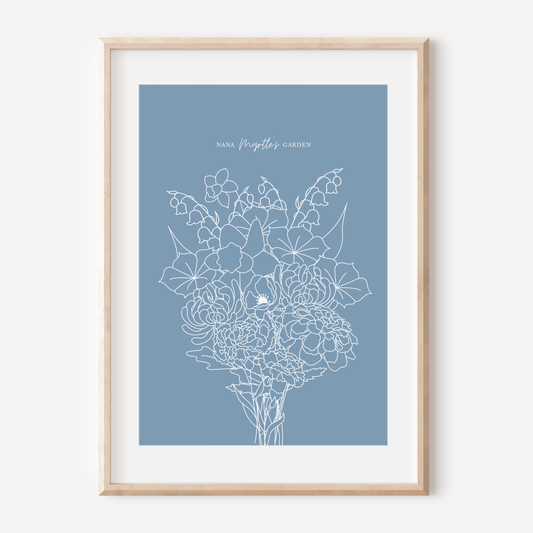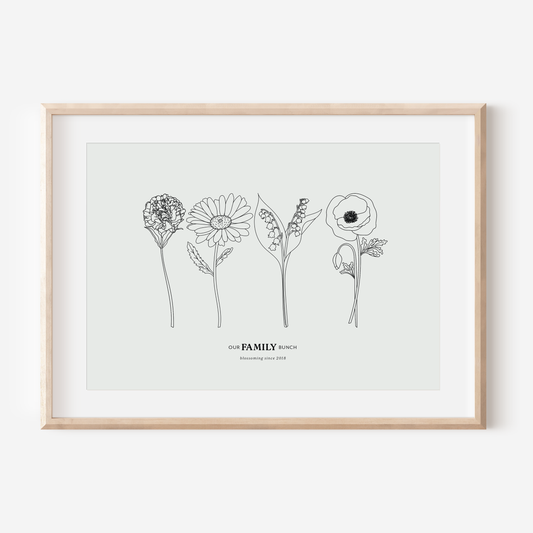Flowers; they have got to be one of the greatest gifts from Mother Nature, alongside a glorious sunset or sunrise, of course! Each birth flower has its own set of associated characteristics, just like the zodiac signs and birthstones have theirs. The meaning of flowers can change depending on their colour. The qualities below are a well-rounded list I've made.

January Birth Flower - Carnation
January has the Carnation as its birth flower. Carnations in full bloom have ruffled silky petals atop either a single stem or a cluster of two to five flowers.
THEY SYMBOLISE
Love, loyalty and devotion.
FUN FACT
Carnations are edible. The petals are often used for decorating cakes or as a salad garnish. No need to be excited; they are pretty bland!
ON A PERSONAL NOTE
Carnations remind me of my late Grandad because gardening was one of his passions, and he was born in January. I strongly remember planting some carnation seeds in the garden at my parents' house in my teens and loved watching them grow.

February Birth Flower - Iris
February has the Iris as its birth flower. Irises have six colourful portions - three petals and three sepals. The three petals stand upright and are commonly known as standards.
THEY SYMBOLISE
Wisdom, friendship, hope and courage.
FUN FACT
The name Iris comes from the Greek word for rainbow. Iris is also the Goddess of the rainbow.

March Birth Flower - Daffodil
March has the Daffodil as its birth flower. Delicate buds of sunshine, Daffodils have cheerful bright blooms comprising six petals surrounding a trumpet. The most commonly known Daffodil is yellow, but there are other colours too.
THEY SYMBOLISE
Rebirth, new beginnings, rejuvenation, happiness, luck, faithfulness and prosperity.
FUN FACT
The correct name for the trumpet of a Daffodil flower is Corona!

April Birth Flower - Daisy
April has the Daisy as its birth flower. Daisies generally have a bright yellow centre surrounded by a rosette of thin white petals.
THEY SYMBOLISE
Innocence, purity, transformation, loyalty and new beginnings.
FUN FACT
A daisy's cousin is the sunflower.

May Birth Flower - Lily of the Valley
May has the Lily of the Valley as its birth flower. Lily of the Valley has many dainty white blossoms clustered on a single stem.
THEY SYMBOLISE
Humility, happiness returning, motherhood and purity.
FUN FACT
Lily of the Valley is a popular bouquet choice for royal brides. It even featured in the bridal bouquet at the wedding of William and Catherine.

June Birth Flower - Rose
June has the Rose as its birth flower. Universally they are loved for their variety of deep, rich coloured blooms, sweet smell and velvety textured petals.
THEY SYMBOLISE
Love, passion, beauty, devotion, honour and confidentiality.
FUN FACT
About two thousand roses are needed to make a single gram of rose oil suitable for use in perfumes.
ON A PERSONAL NOTE
Both my mum and Nanny grow roses, and a rich deep red rose reminds me of my childhood because we had one growing on the side of our driveway.

July Birth Flower - Water Lily
July has the Water Lily as its birth flower. Water lilies are a type of floating flower. The lily pads are aptly named because they allow a single lily flower to rest.
THEY SYMBOLISE
Purity, sweetness, enlightenment, joy and rebirth.
FUN FACT
Water Lilies open and close each day, and their leaves help to provide shade to the aquatic life beneath the surface!

August Birth Flower - Poppy
August has the Poppy as its birth flower. A red Poppy is a known symbol of the First World War but was a symbol of remembrance before this too. Poppy flowers are shaped like cups and have four to six petals.
THEY SYMBOLISE
Remembrance, relaxation, recovery, happiness, enchantment and wealth.
FUN FACT
Poppies are needed to make morphine!
ON A PERSONAL NOTE
My Poppa (great grandfather) was part of the Gallipoli campaign on April 25 1915. I don't hold memories of him as he passed when I was only six months old. But they remind me of both him and his wife, my (great) Nanna.

September Birth Flower - Morning Glory
September has the Morning Glory as its birth flower. Morning Glory produces large, trumpet-shaped flowers with five heart-shaped fused petals.
THEY SYMBOLISE
Love, affection, longing, humility and spontaneity.
FUN FACT
The flowers unfurl in the morning in an impressive display and close in the afternoon, hence being called Morning Glory.

October Birth Flower - Marigold
October has the Marigold as its birth flower. Marigolds flower with bright shades of yellow, red or golden-orange ruffled petals.
THEY SYMBOLISE
Elegance, determination, warmth, passion, fierce love and creativity.
FUN FACT
Marigolds have edible flowers. Most commonly used as an addition to salads or to decorate sweet desserts.

November Birth Flower - Chrysanthemum
November has the Chrysanthemum as its birth flower. Chrysanthemums have many varieties available, including plants that blossom in daisy-like flowers and others that look like pompoms!
THEY SYMBOLISE
Loyalty, honesty, friendship, compassion, joy, optimism, longevity and happiness.
FUN FACT
The first Chrysanthemum ever cultivated was in Japan. Every year on the 9th day of the 9th month (September 9,) they celebrate a Festival of Happiness in celebration of the Chrysanthemum.

December Birth Flower - Jonquil
December has the Jonquil as its birth flower. A Jonquil stem has little bright yellow blossoms appearing in clusters of two to six flowers. Jonquil flowers generally have a sweet scent and are more fragrant than Daffodils.
THEY SYMBOLISE
Hope, wealth, friendship and good fortune.
FUN FACT
Jonquils come from the Narcissus family of flowers. They are both considered both lucky and unlucky when given in a bouquet. If a single Narcissus is gifted, it's believed to bring bad luck and sorrow to the recipient. A Daffodil bouquet will bring good luck.
ON A PERSONAL NOTE
I'm a December baby; Mum had Jonquils growing in our front garden when I was a child.







